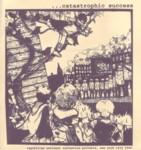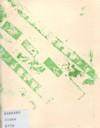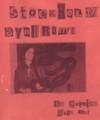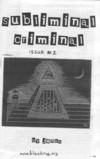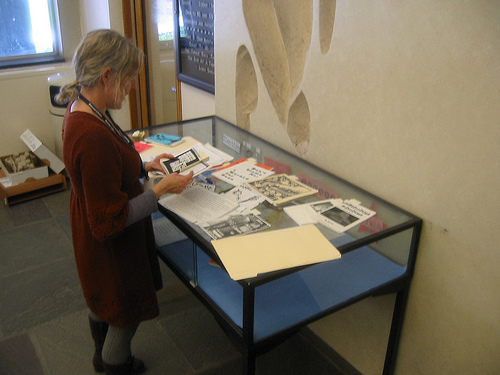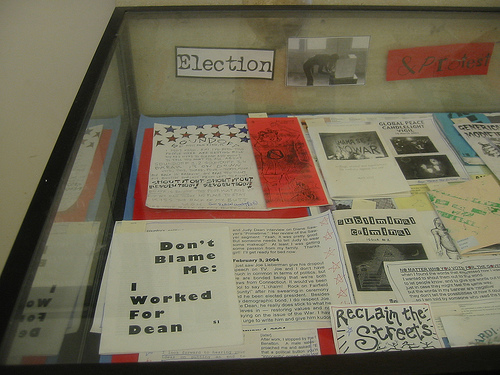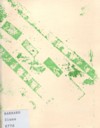Elections & Protest
About the Exhibit
Zines by nature are political. According to Hillary Clark of the zine culture magazine, broken pencil, Putting out a zine, any zine, is a political act. Whether it's the high school kid who does a zine about Sloan, or the collective's newsletter advocating environmental awareness, both are reclaiming what was essentially theirs to begin with. Simply expressing your voice and opinions through an alternative publication like a zine is a political statement, because, when individuals start recognizing and seizing their place in the discussion, rather than merely consuming whats dropped on their doorstep, its not radical, its a restoration of the printed word as it was meant to operate. And the printed word has always been political.
Some zines take participation -- or refusal to participate -- in politics as a theme or guiding idea, using self-published pages as a means of giving voice to challenges and resistance to the political process. The zines in this collection are only the latest incarnation in a long history of political protest through small-run and alternative publication. According to Fred Wright, a zine scholar, political zines of today, hearken back to other, older self-publishing ventures of independent spirit and vitality such as American broadsides from Revolutionary days, Russian Samizdat material, Dada and other avant garde art and social movements' magazines and manifestoes, and beat poetry chapbooks. Whether calling colonialists to arms in the days of the American Revolution or subverting censorship and challenges to free speech in Soviet Russia, zines and alternative publications are a natural and important tool for preserving free speech on matters of politics and power.
From Thomas Paines incendiary proto-zine, Common Sense, to todays radical zines, self-publication has been a vibrant mode of political protest for since the invention of the printing press. From the Republican National Convention to the presidential election, from deciding to take your child to a political rally to challenging politicians to be responsible to their electorate, the zines from Barnards collection featured here provide a glimpse into the political struggles of our times.
For more information, check out: Clark, Hillary. Photocopied Politics: Zines (re)Produce a New Activist Culture. Broken Pencil #6.
Wright, Fred. The History and Characteristics of Zines. 1997. Available: http://www.zinebook.com/resource/wright1.html
About the Election and Protest-Themed Zines Exhibition
Inspired by the Barnard Center for Research on Women's thirty third Scholar and Feminist Conference, "The State of Democracy: Gender and Political Participation," Spring 2008 Zine Intern, Julie Turley, created this collection of election and protest-themed zines selected from the Barnard Library Zine Collection. The physical exhibit, which lives in the library's lobby, features copies of selected zines from Barnard's archival collection as well as photocopied selections of relevant pages and extracts. You can read more about the original exhibit by visiting our livejournal.
For this online exhibition, covers and selections were scanned and digitized for preservation. The work was begun in 2008 by Zine Intern, Melissa L. Jones. Because Melissa is a veteran NYC public school educator, she also worked to write the lesson plans and curriculum support materials.
If you're interested in reading more from these zines, you can use CLIO to check their circulation status. Or come to the Barnard Library and ask for help at the reference desk!
Barnard/Columbia students can come to the library and check out zines any time. Folks from outside the Barnard/Columbia community should email the zine librarian, or check your local distro to find out how to get copies of the zines featured here.
Introduction to Teaching with Zines
What are zines?
"...zines are noncommerical, nonprofessional, small-circulation magazines which their creators produce, publish and distribute themselves." - Stephen Duncombe, Notes from the Underground: Zines and the Politics of Alternative Culture
Why teach with zines?
"Zines...challenge the easily digestible mainstream media. They can open students' eyes to other outlets for information, showing alternate sources and forcing students to see how the accessible information that is often just taken for fact also has origins and agendas." - Amy Wan, "Not Just for Kids Anymore: Using Zines in the Classroom."
Zines and other alternative and underground publications can be used as teaching tools for learners from kindegarten to college. There are zines on just about any topic you can think of, from feminism to sports to politics to cooking. When choosing zines for use in your classroom, think carefully about your student's reading level and the subject matter of the zine. Let students explore zines and their history, and you can teach just about anything, including: English Language Arts, Media Literacy, Art,Social Science and History and even Math and Science!
Essential Questions
This online exhibition was designed to help learners of all ages explore the following Essential Questions:
What is the value of protest?
How can those outside the mainstream get their voices heard?
How do systems of power oppress voices of dissent?
Lesson Plans
The following lesson plans were developed for three different levels of ability, but each lesson plan could be used in any classroom with the appropriate modifcations. Select the lesson plan that best fits your students, or download all three and create your own unit to suit your needs. Each lesson plan was originally developed by Melissa L. Jones, MS Ed, MS LIS, based on her expertise as a public school educator.
Lesson A - What is a zine? What is the value of protest?
Content Areas: English Language Arts, Information Literacy
Level: Intermediate, Grades 7-9
Lesson B - Why zines? How can those outside the mainstream get their voices heard?
Content Areas: Media Literacy, Information Literacy
Level: Secondary, Grades 10-12
Lesson C - How do systems of power repress voices of dissent?
Content Areas: English, History, Political Science, Information Literacy
Level: 12th Grade or Early College
Suggested Resources
Books
Block, Francesca Lia and Hillary Carlip. Zine Scene: the Do it Yourself Guide to Zines. Lost Angeles, CA: Girl Press, 1998.
Duncombe, Stephen. Notes from the Underground: Zines and the Politics of Alternative Culture. Verso, 1997.
Watson, Esther Pearl and Mark Todd. Whatcha Mean What's a Zine? Graphia, 2006.
Articles
Bott, Chiristie. "Zines - The Ultimate Creative Writing Project," English Journal, 92, no. 2 (2002): 27-33.
Congdon, Kristin G. and Doug Blandy. "Using Zines to Teach about Postmodernism and the Communication of Ideas." Art Education. (May 2003).
Daly, Brenda O. "Taking whiteness personally: Learning to teach testimonial reading and writing in the college literature classroom." Pedagogy. vol 5 no. 2 (Spring 2005): p 213-246.
Guzzetti, Barbara J. "Zines for social justice: Adolescent girls writing on their own." Reading Research Quarterly. 39, no. 4 (2004): 408-36.
Sellie, Alycia and Kate Vo Thi-Beard. "Using Zines to Encourage Multiple Literacies," Wisconsin English Journal. v. 47, n. 2. (Fall 2005): 27-33.
Wan, Amy J. "Not Just for Kids Anymore: Using Zines in the Classroom." Radical Teacher. April 30th, 1999.
Web Resources
Freedman, Jenna. DIY Publications and Media Literacy: Zines in the Classroom. Symposium on Media Literacy in Education Conference. Bowling Green, OH. June 2005.
Holdaway, Matt. "A Student's Guide on Zines and Tips on How to Make One."
Williamson, Judith. "Engaging Resistant Writers Through Zines in the Classroom." The Zine and E-Zine Resource Guide. 1994.
Wright, Fred. "The History and Characteristics of Zines." The Zine and E-Zine Resource Guide. 1997.
"Zines 101." Zine World Website. June 2007.
